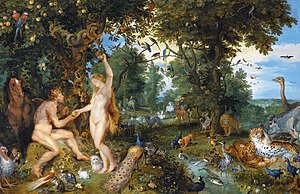
Back Tuin van Eden Afrikaans የዔድን ገነት Amharic جنات عدن Arabic Ədən bağı Azerbaijani عدن باغی AZB Tatamnan nin Eden BCL জান্নাতুল আদন Bengali/Bangla ཡེ་དེན་གྱི་ལདུམ་རའི་སྐོར། Tibetan Liorzh Eden Breton Jardí de l'Edèn Catalan

In Abrahamic religions, the Garden of Eden (Biblical Hebrew: גַּן־עֵדֶן, romanized: gan-ʿĒḏen; Greek: Εδέμ; Latin: Paradisus) or Garden of God (גַּן־יְהֹוֶה, gan-YHWH and גַן־אֱלֹהִים, gan-Elohim), also called the Terrestrial Paradise, is the biblical paradise described in Genesis 2–3 and Ezekiel 28 and 31.[1][2]
The location of Eden is described in the Book of Genesis as the source of four tributaries. Various suggestions have been made for its location:[3] at the head of the Persian Gulf, in southern Mesopotamia where the Tigris and Euphrates rivers run into the sea;[4] in Armenia, and even in Jackson County, Missouri.[5][6][7][8] Others theorize that Eden was the entire Fertile Crescent[9] or a region of "considerable size" in Mesopotamia, where its native inhabitants still exist in cities such as Telassar.[10][11]
Like the Genesis flood narrative, the Genesis creation narrative and the account of the Tower of Babel, the story of Eden echoes the Mesopotamian myth of a king, as a primordial man, who is placed in a divine garden to guard the tree of life.[12] Scholars note that the Eden narrative shows parallels with aspects of Solomon's Temple and Jerusalem, attesting to its nature as a sacred place.[13][14] Mentions of Eden are also made in the Bible elsewhere in Genesis,[15] in Isaiah 51:3,[16] Ezekiel 36:35,[17] and Joel 2:3;[18] Zechariah 14 and Ezekiel 47 use paradisical imagery without naming Eden.[19]
The name derives from the Akkadian edinnu, from a Sumerian word edin meaning 'plain' or 'steppe', closely related to an Aramaic root word meaning 'fruitful, well-watered'.[2] Another interpretation associates the name with a Hebrew word for 'pleasure';[20] thus the Vulgate reads paradisum voluptatis in Genesis 2:8, and the Douay–Rheims Bible, following, has the wording "And the Lord God had planted a paradise of pleasure".[21]
- ^ Metzger, Bruce Manning; Coogan, Michael D (2004). The Oxford Guide To People And Places Of The Bible. Oxford University Press. p. 62. ISBN 978-0-19-517610-0. Retrieved 22 December 2012.
- ^ a b Cohen 2011, pp. 228–229.
- ^ Cite error: The named reference
wilensky2012was invoked but never defined (see the help page). - ^ Cite error: The named reference
Hamblin-1987was invoked but never defined (see the help page). - ^ "Where is the Garden of Eden? Why the LDS owns over 3,000 acres in Missouri". December 2021.
- ^ Cite error: The named reference
Zevitwas invoked but never defined (see the help page). - ^ Cite error: The named reference
Duncanwas invoked but never defined (see the help page). - ^ Cite error: The named reference
Scafiwas invoked but never defined (see the help page). - ^ Mark, Joshua J. (March 28, 2018). "Fertile Crescent". World History Encyclopedia.
- ^ "Telassar in the International Standard Bible Encyclopedia".
- ^ "Isaiah 37: Barnes Commentary". Biblehub. 2023.
- ^ Davidson 1973, p. 33.
- ^ Cite error: The named reference
Stagerwas invoked but never defined (see the help page). - ^ Kang, Seung Il (2020). "The Garden of Eden as an Israelite Sacred Place". Theology Today. 77 (1): 89–99. doi:10.1177/0040573617731712.
- ^ Genesis 13:10.
- ^ Isaiah 51:3.
- ^ Ezekiel 36:35.
- ^ Joel 2:3.
- ^ Tigchelaar 1999, p. 37.
- ^ Day 2014, p. 26.
- ^ "Latin Vulgate Bible with Douay–Rheims and King James Version Side-by-Side+Complete Sayings of Jesus Christ". www.latinvulgate.com. Archived from the original on 2021-03-12. Retrieved 2021-03-10.